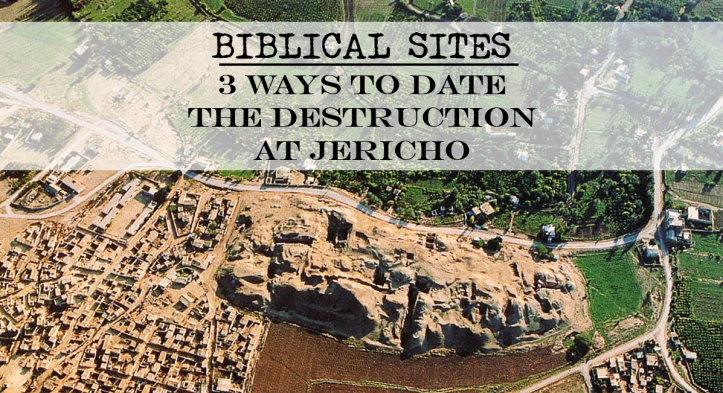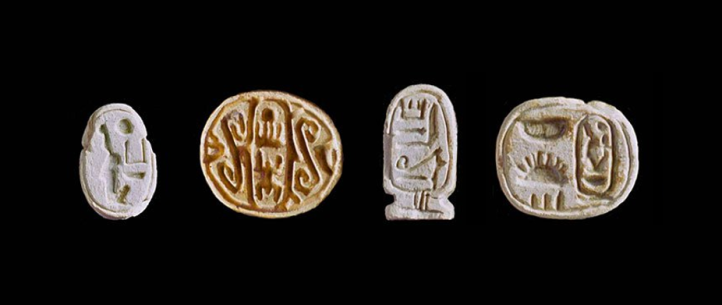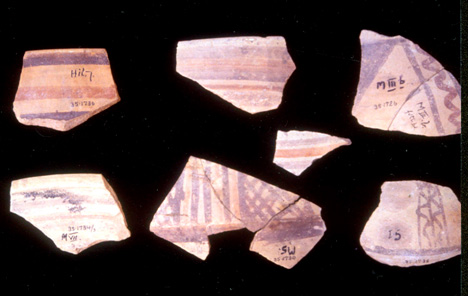
Children in Sunday School often sing, “Joshua fought the battle of Jericho, Jericho, Jericho. Joshua fought the battle of Jericho and the walls came a-tumbling down.” But did the walls of Jericho really come tumbling down as the Bible describes? The ancient city of Jericho has become a “ground zero” for the debate around the historicity of the conquest of Canaan and the reliability of the Bible in general.
The controversy centers on the dating of the destruction of City IV at Jericho. Everyone agrees that Canaanite Jericho was destroyed in a violent, fiery manner. Not everyone agrees on the date that this happened. The first excavators, Sellin and Watzinger, who dug from 1907 to 1909, concluded that Jericho had been destroyed in the Middle Bronze Age, by at least 1600 BC.2 In the 1930’s, British archaeologist, John Garstang excavated a residential area of Jericho and concluded that the fiery destruction of the city occurred in the Late Bronze Age, ca. 1400 BC, linking it with Joshua and the Israelites.3 From 1952-58, Dame Kathleen Kenyon excavated at Jericho and dated the destruction of City IV to the end of the Middle Bronze Age, ca 1550 BC4, meaning that there was no city of Jericho for Joshua to conquer at the time the Bible describes the conquest of Canaan. More recently, archaeologist Bryant Wood has suggested that Kenyon’s analysis of the date of this destruction is incorrect, as she based her conclusions largely on the absence of Cypriot bichrome pottery.5
So who is correct? When was Jericho destroyed? Was it in the Late Bronze Age around 1406 BC, as the Bible suggests (based on 1 Kings 6:1, Judges 11:26-27, Acts 13:19-20 and the number of generations listed 1 Chron. 6:33-38)6 or was it destroyed at the end of the Middle Bronze Age around 1550 BC? To answer this, let’s look at three of the ways scholars have attempted to date the destruction layer at Jericho.
Carbon-14

Carbon-14 dating measures the decay of radiocarbon isotopes in organic matter. Assuming the ratio of C-14 in the past was the same as today, scientists measure the proportion of remaining carbon-14 in a sample to determine the amount of time elapsed since the death of the source. Results are given in a number of years BP (Before Present), and then converted into calendar years.7 Carbon-14 is normally accurate to within 15 years, but the older the sample, the more necessary it is to calibrate and corroborate dates using other means.8 Indeed, there is a current debate in the field of archaeology concerning how accurate Carbon-14 dating is in the Levant9, as well as whether there is a need to recalibrate the curve used in radiocarbon calculations.10
Over the years several samples of charcoal and grain seeds from the final Canaanite city at Jericho have been tested for C-14 levels. The current Italian-Palestinian excavation team, directed by Lorenzo Nigro, tested two samples from the final destruction of the city in 2000; one sample dated to 1347 BC (+/- 85 years) and the other dated to 1597 (+/- 91 years).11 Archaeologist, Dr. Titus Kennedy, has summarized: “The first of these dates fits roughly around the proposed 1400 BC destruction, while the other is closer to the proposed 1550 BC destruction…these dates are so broad that they are useless in contributing to solving the problem for the date of destruction. Overall, the C-14 dates from the destruction of the Bronze Age city of Jericho range from as high as 1883 BC to as low as 1262 BC—a range of over 600 years.”12 Clearly we will need to look to other methods to determine when Jericho was destroyed.
Glyphs and Inscriptions
Artifacts with glyphs (carved symbols) and inscriptions (written texts) are very helpful in establishing the date that a site was occupied. Both the style of the object in question (typology) and the style of writing on it (epigraphy) are used by scholars to determine when the artifact was made. Inscriptions are found often found on monuments, clay tablets, scarabs, etc.
Scarabs are Egyptian amulets in the shape of a dung beetle that often include an inscription on the bottom. Because they were widely collected and distributed in antiquity they are frequently found in digs throughout Israel. Sometimes scarabs include the name of a particular pharaoh, which makes them helpful in archaeological dating.
When Garstang excavated Jericho in the 1930’s he discovered several Egyptian scarabs in tombs to the northwest of the city. The scarabs bore inscriptions with the royal names of three Pharaohs:
- Hatshepsut (ca. 1503-1483 BC)
- Thutmose III (ca 1504-1450 BC)
- Amenhotep III (ca. 1386 BC-1349 BC)13

Pharaohs like Thutmose III and Amenhotep III were popular and revered long after they died. Consequently, their scarabs were copied and collected for many years. Hatshepsut, however, was despised and her name was systematically erased from inscriptions in Egypt in antiquity. Her scarabs are rare because they were not copied or kept as good-luck charms. The rarity of Hatshepsut scarabs makes them excellent chronological indicators.14 In addition to these, Kenyon herself discovered an inscribed cowrie (snail shell), which has been dated to 1485 BC.15 Taken together, the continuous nature of the dates of these scarabs and cowrie demonstrate that the cemetery outside Jericho was actively used through to the end of the 15th century BC.16 This contradicts Kenyon’s claim that the city had been abandoned after it was supposedly destroyed in 1550 BC.
The current lead excavator, Lorenzo Nigro, while espousing Kenyon’s dating, acknowledges that the site was occupied during the Late Bronze Age. He notes, “On the eastern flank of the tell, Garstang retrieved a LB clay tablet preserving an administrative text, which suggests that the city still had a political role, a palace, a ruler, and even an archive.”17
The glyphic and inscriptional evidence demonstrates that Kenyon’s interpretation that Jericho was abandoned at the time of the Conquest of Canaan in 1406 BC is incorrect.
Ceramic Typology
Ceramic Typology is the classification of pottery based on its physical characteristics. Archaeologist, such as Petrie, Albright, and Glueck demonstrated that the different styles of pottery could be used to date the strata in which they were discovered. Today, ceramic typology is one of the most important and accurate means of dating in archaeology.17 Many excavations end each day with “pottery reading” to determine the date of the pottery based on the rims, handles, grit and markings of the sherds that were unearthed.
Archaeologist, Dr. Bryant Wood, an expert in Canaanite pottery, conducted a comprehensive study of the excavation reports of Garstang and the various writings of Kenyon (she never produced an excavation report on Jericho before she died, although one was published posthumously). Wood discovered that Kenyon had based her dating of the destruction of Jericho solely on the absence of imported pottery. During her excavations at Jericho, Kenyon did not find any imported bichrome (two-color) pottery from Cyprus, which is a prime indicator of Late Bronze I occupation. Thus, she concluded that it was unoccupied at his time and had been destroyed 150 years earlier.18 (She would have done well to follow esteemed Egyptologist, Kenneth Kitchen’s maxim, “The absence of evidence is not evidence of absence.”)

Inexplicably, Kenyon seems to have failed to consider the pottery discovered by Garstang. He had unearthed numerous examples of a locally made, imitation bichrome “Cypriot” pottery from the destruction layer of the final Canaanite city of Jericho. Garstang called it “red ware” and several of the pieces he published have classic Cypriot bichrome motifs.19 Locally made imitation bichrome pottery came into use in the Late Bronze IB period and was no longer made in the Late Bronze IIA.20 Since both Garstang and Kenyon were digging in the poorer sections of Jericho, it’s hardly surprising that only locally made bichrome pottery was found, and that the real, fancy, Cypriot bichrome pottery was absent. The local pottery that Garstang and Kenyon found indicates that Jericho was destroyed around 1400 BC.
Summary
Both Garstang and Kenyon conducted significant excavations at Jericho. Both were excellent field archaeologists Garstang meticulously analyzed the pottery he excavated and Kenyon carefully improved excavation methodology in general. Yet both differed on their interpretation of the data. While the Carbon-14 data is of no help in determining the date of the destruction of Jericho, the dating of from glyphic/inscriptional evidence and ceramic typology would indicate that Garstang’s original date of ca. 1400 BC is the correct date. This would support the biblical chronology of Joshua’s army destroying Jericho in what we now call the Late Bronze Age I.
Title Photo: Fullo88 / Wikimedia Commons / Public Domain
Endnotes:
1 William G. Dever, Recent Archaeological Discoveries and Biblical Research (Seattle: University of Washington Press, 1990), 46.
2 Bryant Wood, “Did the Israelites Conquer Jericho? A New Look at the Archaeological Evidence,” BAR 16:2 (1990): 44-58, 53. Online: https://biblearchaeology.org/research/conquest-of-canaan/2310-did-the-israelites-conquer-jericho-a-new-look-at-the-archaeological-evidence?highlight=WyJjeXByaW90Il0= (Accessed May 9, 2019).
3 John Garstang, “Jericho and the Biblical Story,” in Wonders of the Past, ed. J.A. Hammerton (New York: Wise, 1937), 1222.
4 Kathleen Kenyon, Digging Up Jericho (London: Ernest Benn, 1957), 262.
5 Bryant Wood, “Did the Israelites Conquer Jericho? A New Look at the Archaeological Evidence,” BAR 16:2 (1990): 44-58, 53. Online: https://biblearchaeology.org/research/conquest-of-canaan/2310-did-the-israelites-conquer-jericho-a-new-look-at-the-archaeological-evidence?highlight=WyJjeXByaW90Il0= (Accessed May 9, 2019).
6 A good summary of the verses that point to an early date for the Exodus (and by implication the conquest 40 years later) in the 15th century B.C. can be found in the following episodes of Digging for Truth: https://www.youtube.com/watch?v=bxXXTGD_y40&t=1312s and https://www.youtube.com/watch?v=8-mUoS5RvBU&t=1379s In addition, these episodes of Digging for Truth highlight the archaeological evidence for an early Exodus/Conquest: https://www.youtube.com/watch?v=iPYkoKyRfKw&t=1s and https://www.youtube.com/watch?v=XpRUe6-tkzQ&t=20s
7 “Radiocarbon Dating and Archaeology,” Beta Analytic Testing Laboratory, https://www.radiocarbon.com/archaeology.htm (Accessed May 10, 2019).
8 Scott Stripling, The Trowel and the Truth (Ramona: Vision Publishing, 2017), 53.
9 Sturt W. Manning, Carol Griggs, Brita Lorentzen, Christopher Bronk Ramsey, David Chivall, A. J. Timothy Jull, and Todd E. Lange, “Fluctuating radiocarbon offsets observed in the southern Levant and implications for archaeological chronology debates,” PNAS June 12, 2018 115 (24) 6141-6146; first published May 29, 2018 https://doi.org/10.1073/pnas.1719420115 (Accessed May 11, 2019).
10 Daniel Aloi, “New radiocarbon cycle research may alter history” Cornell Chronicle, June 1, 2018. http://news.cornell.edu/stories/2018/06/new-radiocarbon-cycle-research-may-alter-history (Accessed May 11, 2019)
11 Bryant Wood, “Carbon 14 Dating at Jericho” Associates for Biblical Research, August 7, 2008. https://biblearchaeology.org/research/conquest-of-canaan/4051-carbon-14-dating-at-jericho (Accessed May 11, 2019).
12 Titus Kennedy, “Carbon-14 Dates at Jericho and the Destruction Date” APXAIOC, October 22, 2012. http://www.apxaioc.com/article/carbon-14-dates-jericho-and-destruction-date (Accessed, May 11, 2019).
13 Bryant Wood, “Did the Israelites Conquer Jericho? A New Look at the Archaeological Evidence,” BAR 16:2 (1990): 44-58, 53. Online: https://biblearchaeology.org/research/conquest-of-canaan/2310-did-the-israelites-conquer-jericho-a-new-look-at-the-archaeological-evidence?highlight=WyJjeXByaW90Il0= (Accessed May 9, 2019).
14 Ibid.
15 Bryant Wood, “Digging Past The Doubts,” Answers In Genesis. October 1, 2015. https://answersingenesis.org/archaeology/digging-past-doubts/ (Accessed May 13, 2019).
16 Bryant Wood, “Dating Jericho’s Destruction: Bienkowski is Wrong on All Counts,” Associates for Biblical Research, March 28, 2012. https://biblearchaeology.org/research/conquest-of-canaan/2945-dating-jerichos-destruction-bienkowski-is-wrong-on-all-counts?highlight=WyJzY2FyYWJzIiwiJ3NjYXJhYnMiXQ== (Accessed May 11, 2019).
16 Lorenzo Nigro, “TELL ES-SULTAN 2015 A Pilot Project for Archaeology in Palestine,” Near Easter Archaeology 79:1 (2016), 16. Online: http://www.lasapienzatojericho.it/Biblioteca/Jericho/TELL_ES-SULTAN_Jericho_2015_A_Pilot_Proj.pdf (Accessed May 13, 2019).
17 Scott Stripling, The Trowel and the Truth (Ramona: Vision Publishing, 2017), 52.
18 Bryant Wood, “Did the Israelites Conquer Jericho? A New Look at the Archaeological Evidence,” BAR 16:2 (1990): 44-58, 53. Online: https://biblearchaeology.org/research/conquest-of-canaan/2310-did-the-israelites-conquer-jericho-a-new-look-at-the-archaeological-evidence?highlight=WyJjeXByaW90Il0= (Accessed May 9, 2019).
19 Bryant Wood, “Dating Jericho’s Destruction: Bienkowski is Wrong on All Counts,” Associates for Biblical Research, March 28, 2012. https://biblearchaeology.org/research/conquest-of-canaan/2945-dating-jerichos-destruction-bienkowski-is-wrong-on-all-counts?highlight=WyJzY2FyYWJzIiwiJ3NjYXJhYnMiXQ== (Accessed May 11, 2019).
20 Bryant Wood, Personal email to the author. May 10, 2019.

[…] (8:28), and Hazor (11:11). Indeed, we do find archaeological evidence of destruction by fire at Jericho, Ai, and Hazor around 1400 BC, exactly as the Bible describes. In Joshua 6, we read a description […]
[…] Jericho had not one wall, but two: an inner wall and an outer wall. The outer mud brick wall had been built atop a retaining wall. Between the two walls was a sloped embankment, with an upper wall encircling the inner city. Excavators, Sellin and Watzinger, discovered that the retaining wall was 12-15 ft high, with a 20-26 ft high mudbrick wall on top of that. At the top of the embankment, was another mudbrick wall.2 These walls had been constructed in the Middle Bronze age3, and stood until the destruction of Jericho under Joshua in the Late Bronze Age, ca. 1406 BC4. […]
[…] Sources: https://www.thoughtco.com/history-of-the-microscope-1992146https://en.wikipedia.org/wiki/Radiocarbon_datinghttps://www.ancient.eu/article/951/early-jericho/https://biblearchaeologyreport.com/2019/05/17/biblical-places-three-ways-to-date-the-destruction-at-…https://en.wikipedia.org/wiki/Iron_Age […]
[…] Biblical sites : Three ways to date the destruction at Jericho […]
[…] Bien des archéologues diraient qu’il n’y a pas de preuve de cette conquête à la fin de l’âge de bronze, mais tout comme pour les preuves de l’Exode, en regardant au bon endroit et au bon moment on trouve beaucoup d’éléments satisfaisants1. […]